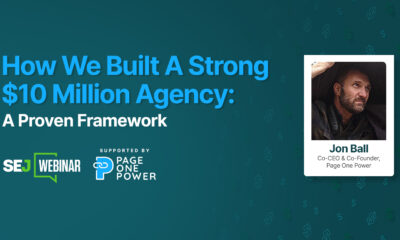SOCIAL
The Development of Roblox Provides a Framework for the Metaverse Vision

As the metaverse hype cycle continues to churn, and profiteers seek to capitalize on the early knowledge gap, the truth is that we’re still a long way off being able to interact and engage in a fully-immersive, fully-functional digital space
But we do already have basic templates for what the metaverse may look like, in game worlds like Roblox, where youngsters interact via digital avatars, and move from experience to experience in a 3D environment, all of which is increasingly designed by users, in all aspects.
And with those younger audiences now growing up, Roblox is looking to take its in-world experiences to the next level, with new ad types and branded content experiences, and improved visual elements, all designed to appeal to older consumers.
Which is worth noting, both as an immediate ad option (Roblox has over 52 million engaged active users), but also, again, as a template for what’s coming, and how brands could consider their own metaverse experiences and approaches in the next stage.
First off, Roblox is rolling out new interactive billboards and posters within its virtual worlds, providing a new way for brands to connect with Roblox users in specific experiences – and for Roblox creators to make money.
As reported by The Verge:
“Working initially with a group of selected companies and developers, the new ad system will allow creators to drop 3D ads into their own experiences – like a billboard in a sports stadium or on top of a cab in a game – and to get a cut of the ad revenue.”
As noted, much of the Roblox experience is now created by the user community, with external developers building their experiences on the Roblox engine – which is exactly how Meta’s metaverse vision will also come together.
Meta already has its own Horizon Worlds virtual sandbox environment, which could theoretically replicate the Roblox experience, but in VR instead.
You can see, then, how similar ad offerings could help to support VR creators working in the space, with Meta then hosting the party as more and more VR creators come across and build entire worlds in its virtual realm.
That’s Zuckerberg’s dream, that eventually, Meta will be the dominant player in this emerging VR world, which will force all creators and brands who also want to take part to build on its tools, securing Meta’s future as the key facilitator of the metaverse experience.
As much as Meta is keen to say that no one company will own the metaverse, that’s exactly what it’s aiming to achieve. And even if it doesn’t dominate the space, as such, it’ll likely dominate VR headset sales, and advanced social connection in the space.
In this sense, Roblox actually provides a solid, working, small-scale example of Meta’s metaverse vision – which is another reason why it’s worth noting its latest developments.
Brands on Roblox will also soon be able to add ‘portals’ in Roblox experiences, which will transport users from one world into a branded digital environment.
Brands are also exploring the sale of virtual items in Roblox, as accessories for in-game characters, which is another opportunity for businesses in the virtual space.
Roblox has also outlined its more evolved avatars, coming soon, which look much more like the metaverse avatars we’re seeing on other platforms.

It’s also working on improved motion capture for character animation, another step towards improved avatars in the app.
Better looking avatars, new brand experiences, more digital items. Again, you can see the metaverse vision in small-scale – while Roblox also continues to establish a solid framework for creator payments, with creators able to earn money based on the amount of time users spend in their game or experience. Roblox says that it paid out $538 million to creators via this process in 2021 alone.
You can imagine that Meta would love to implement the same, establishing a revenue share deal that will incentivize top creators to build their own Horizon Worlds VR experience.
That’s how Meta can ensure that its metaverse stays relevant – and again, as with all of these elements, you can see how Meta could use a similar framework, overall, to grow its VR environment.
It remains an uncertain bet. People thus far have been unimpressed by the shared visuals of Meta’s metaverse experience, and if they’re not wowed by the graphics, and the capacity of the space, they’re not going to rush out and buy a VR headset.
This post could end up being a defining moment in Meta’s metaverse development. Despite sinking billions into its VR projects, the current visual depth and detail on display is not amazing, and with Meta also upping the price of its VR headsets due to rising production costs (its coming ‘Cambria’ advanced VR unit will reportedly cost $1000), it remains a hard sell to get the majority of people across, and into its metaverse space, for the time being.
Meta will be looking to counter this at its upcoming Connect VR conference, and it remains confident that immersive VR connection will be the future of social interaction.
Platforms like Roblox are part of the reason for that confidence, and with over half of US kids under 16 engaging in Roblox’s virtual world, you can see why Meta would believe that these types of integrated, immersive experiences will increasingly become the norm for the next generation.
It’ll take time – and definitely, don’t believe those companies that are telling you that the metaverse already exists, or that you need a metaverse strategy right away.
You don’t, but one day, based on how younger users are engaging, and how these digital worlds are transforming social norms, it could well become the next big thing, and it may be that Zuck and Co are right, and we will all be spending hours locked into VR worlds, interacting in all new ways.
There’s a lot that needs to go right for this to happen, but in game worlds like Roblox, Minecraft and Fortnite, you can get a sense of what could be, a sort of scale model for what’s envisioned for the next stage.
SOCIAL
Snapchat Explores New Messaging Retention Feature: A Game-Changer or Risky Move?

In a recent announcement, Snapchat revealed a groundbreaking update that challenges its traditional design ethos. The platform is experimenting with an option that allows users to defy the 24-hour auto-delete rule, a feature synonymous with Snapchat’s ephemeral messaging model.
The proposed change aims to introduce a “Never delete” option in messaging retention settings, aligning Snapchat more closely with conventional messaging apps. While this move may blur Snapchat’s distinctive selling point, Snap appears convinced of its necessity.
According to Snap, the decision stems from user feedback and a commitment to innovation based on user needs. The company aims to provide greater flexibility and control over conversations, catering to the preferences of its community.
Currently undergoing trials in select markets, the new feature empowers users to adjust retention settings on a conversation-by-conversation basis. Flexibility remains paramount, with participants able to modify settings within chats and receive in-chat notifications to ensure transparency.
Snapchat underscores that the default auto-delete feature will persist, reinforcing its design philosophy centered on ephemerality. However, with the app gaining traction as a primary messaging platform, the option offers users a means to preserve longer chat histories.
The update marks a pivotal moment for Snapchat, renowned for its disappearing message premise, especially popular among younger demographics. Retaining this focus has been pivotal to Snapchat’s identity, but the shift suggests a broader strategy aimed at diversifying its user base.
This strategy may appeal particularly to older demographics, potentially extending Snapchat’s relevance as users age. By emulating features of conventional messaging platforms, Snapchat seeks to enhance its appeal and broaden its reach.
Yet, the introduction of message retention poses questions about Snapchat’s uniqueness. While addressing user demands, the risk of diluting Snapchat’s distinctiveness looms large.
As Snapchat ventures into uncharted territory, the outcome of this experiment remains uncertain. Will message retention propel Snapchat to new heights, or will it compromise the platform’s uniqueness?
Only time will tell.
SOCIAL
Catering to specific audience boosts your business, says accountant turned coach

While it is tempting to try to appeal to a broad audience, the founder of alcohol-free coaching service Just the Tonic, Sandra Parker, believes the best thing you can do for your business is focus on your niche. Here’s how she did just that.
When running a business, reaching out to as many clients as possible can be tempting. But it also risks making your marketing “too generic,” warns Sandra Parker, the founder of Just The Tonic Coaching.
“From the very start of my business, I knew exactly who I could help and who I couldn’t,” Parker told My Biggest Lessons.
Parker struggled with alcohol dependence as a young professional. Today, her business targets high-achieving individuals who face challenges similar to those she had early in her career.
“I understand their frustrations, I understand their fears, and I understand their coping mechanisms and the stories they’re telling themselves,” Parker said. “Because of that, I’m able to market very effectively, to speak in a language that they understand, and am able to reach them.”Â
“I believe that it’s really important that you know exactly who your customer or your client is, and you target them, and you resist the temptation to make your marketing too generic to try and reach everyone,” she explained.
“If you speak specifically to your target clients, you will reach them, and I believe that’s the way that you’re going to be more successful.
Watch the video for more of Sandra Parker’s biggest lessons.
SOCIAL
Instagram Tests Live-Stream Games to Enhance Engagement

Instagram’s testing out some new options to help spice up your live-streams in the app, with some live broadcasters now able to select a game that they can play with viewers in-stream.
As you can see in these example screens, posted by Ahmed Ghanem, some creators now have the option to play either “This or That”, a question and answer prompt that you can share with your viewers, or “Trivia”, to generate more engagement within your IG live-streams.
That could be a simple way to spark more conversation and interaction, which could then lead into further engagement opportunities from your live audience.
Meta’s been exploring more ways to make live-streaming a bigger consideration for IG creators, with a view to live-streams potentially catching on with more users.
That includes the gradual expansion of its “Stars” live-stream donation program, giving more creators in more regions a means to accept donations from live-stream viewers, while back in December, Instagram also added some new options to make it easier to go live using third-party tools via desktop PCs.
Live streaming has been a major shift in China, where shopping live-streams, in particular, have led to massive opportunities for streaming platforms. They haven’t caught on in the same way in Western regions, but as TikTok and YouTube look to push live-stream adoption, there is still a chance that they will become a much bigger element in future.
Which is why IG is also trying to stay in touch, and add more ways for its creators to engage via streams. Live-stream games is another element within this, which could make this a better community-building, and potentially sales-driving option.
We’ve asked Instagram for more information on this test, and we’ll update this post if/when we hear back.
-

 MARKETING7 days ago
MARKETING7 days agoRoundel Media Studio: What to Expect From Target’s New Self-Service Platform
-

 SEO6 days ago
SEO6 days agoGoogle Limits News Links In California Over Proposed ‘Link Tax’ Law
-
SEARCHENGINES7 days ago
Daily Search Forum Recap: April 12, 2024
-

 SEARCHENGINES5 days ago
SEARCHENGINES5 days agoGoogle Core Update Volatility, Helpful Content Update Gone, Dangerous Google Search Results & Google Ads Confusion
-

 SEO5 days ago
SEO5 days ago10 Paid Search & PPC Planning Best Practices
-

 MARKETING6 days ago
MARKETING6 days ago2 Ways to Take Back the Power in Your Business: Part 2
-

 MARKETING4 days ago
MARKETING4 days ago5 Psychological Tactics to Write Better Emails
-

 SEARCHENGINES4 days ago
SEARCHENGINES4 days agoWeekend Google Core Ranking Volatility















You must be logged in to post a comment Login